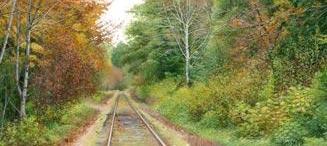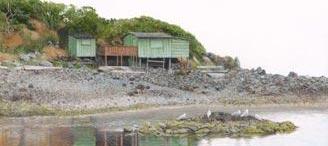
5 minute read
The World of Miniature Art by Tiffany Hastie
Born and raised on the west coast of British Columbia, Tiffany Hastie has always held a deep appreciation for the natural beauty surrounding her. The permanence of landscape and architecture, when combined with the ever-changing light, provides an endless source of inspiration and challenge. The tension created when painting the “Grand View” in miniature offers a type of intimacy that draws the viewer inward. It is this alluring quality inherent in miniature painting that Tiffany finds fascinating to work with.

Beached, 2.25 x 4.75
Advertisement
How did you become interested in the world of miniature work?
I first heard about miniature painting twenty years ago at a meeting of the Federation of Canadian Artists, on the Lower Mainland. Our chapter president had recently been to a miniature show in the USA and after telling us about it we decided to include a miniature component in our chapter show. Instinctively I felt this was a good fit for my realistic and detailed style of work, so I painted four miniatures for the show. The paintings sold within five minutes of the opening and I had a commission for four more paintings by the end of the evening. After this encouraging start, I took a deep dive into the world of miniature art and focused on developing my skills further.
How long have you been painting and teaching miniatures?
I’ve been painting miniature landscapes and teaching the art of painting in miniature for about twenty years now. Considering this traditional form of painting dates back a thousand years or so, it is terrific to see quite a bit of interest in miniatures today, both from artists wanting to learn the technique, and from buyers who collect these tiny artworks.
Please explain the difference between traditional miniature paintings and paintings that are just small in size?
Having painted both small paintings and miniatures, I’ve found the main difference between them has to do with concept and technique. In concept, miniature painting is about rendering a subject in miniature (approximately 1/6th or so in scale of the original), without omitting any detail along the way. Traditionally, a miniature painting is considered to be a painting that can be held in the palm of one hand, with the understanding that if the painting were to be enlarged many times over, the image would appear just as complete and whole on a large scale, as it does on a tiny one.
With regard to technique, miniature painting requires a certain precision of execution so that the resulting image remains within the concept of miniaturization. Good quality materials are a must, as are patience and focus. Working with acrylic on art board, I use techniques such as hatching, stippling and pointillism, along with numerous thin applications of paint to slowly build the image up. It usually takes me fifteen plus hours to paint a 2” x 4” miniature. Given the nature of how the images are created, miniature paintings tend to draw the viewer into the image, as the painting reveals more of itself the longer one looks at it. For this reason, many people like to view a miniature painting under a magnifying glass to fully appreciate the details.
Do you ever work larger and if so, how do you make that transition?
Yes, I do. At the moment there is a large three-foot by four-foot canvas on my easel which gives me a good change from the minis. Painting in miniature means sitting for long hours at my drafting table, so I frequently take breaks to get up and move around. During this time I’ll paint for a while at my easel, working with pattern and design, and leave the landscapes for my miniature format. I find working on a different scale, with a different focus, provides a great opportunity to clear my mind and stretch creatively, before returning to miniature work with fresh eyes.
Do you have any upcoming shows?
Right now I’m working on a couple of miniatures for the upcoming 86th Annual International Exhibition of Fine Art in Miniature, hosted by The Miniature Painters, Sculptors & Gravers Society of Washington, D.C.. This show provides an excellent opportunity to see miniature work in all of it’s forms and mediums, for those who may be interested in exploring the world of miniature art.

Beacon Hill Bluebells, 2 x 4.5”
Note: the west coast painting at the MPSGS International Art Show has been awarded Best in Realism. I'm also looking forward to participating in the 2019 Vancouver Island Miniature Masterpiece Art Show hosted by Excellent Frameworks in Duncan. It's great to see an increasing interest in miniature work and I think this show will be a lot of fun.
What advise would you give artists who are thinking of stepping into the world of miniatures?
My advice to artists who are interested in miniature work is to research miniature painting shows online and see a miniature in real life, if possible, to best understand the unique nature of them. Alternatively, there are many excellent websites which showcase miniature paintings and explain the purpose, history, materials and techniques used. If you want to try your hand at miniature painting, then use smoothest painting surface you can find, the tiniest paintbrushes and paint in the smallest, thinnest applications. Build your image up slowly, removing any dust and debris, and use the smallest painting strokes possible. Painting in miniature can be challenging, but it offers it's own excellent rewards and is well worth pursuing. Here are several websites for some of the leading miniature organizations with show dates and helpful information: www.mpsgs.org (Miniature Painters, Sculptors & Gravers Society of Washington, DC) www.hilliardsociety.org (Hilliard Society of Miniature Art) www.royal-miniature-society.org.uk (The Royal Society of Miniature Painters, Sculptors & Gravers) www.miniature-art.com (The Miniature Art Society of Florida) ~

Shack Island, 2 x 4.5”
The World of Miniature Art by Tiffany Hastie tiffanyhastieart.com


